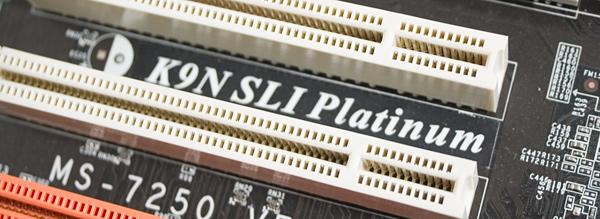MSI K9N SLI Platinum nForce 570 SLI Motherboard
Overview
Nvidia's SLI technology launched in mid-2004, and was designed to provide high-performance rendering power for gamers. Because the technology was brand new, and the fastest thing on the market, SLI configurations demanded exorbitant price premiums over single card configurations, despite first generation issues like software compatibility, driver problems, and hardware issues. Setting up a "budget" SLI system was simply out of the question at first, as SLI-enabled graphics cards were only available at the high end of the price range, as were SLI-enabled motherboards.
Now that Nvidia's GeForce 6 and 7-series lineups (both SLI enabled) have been out-dated by the new GeForce 8 lineup, we're seeing prices on SLI-enabled hardware fall to surprisingly low levels. There are now thousands of prospective choices for setting up an SLI-enabled machine, as Nvidia has enabled this technology on graphics cards as inexpensive as $50, and SLI-equipped motherboards can be had for under $100 as well. While it used to cost a minimum of $1,000 for SLI technology, going SLI today is easy and inexpensive - not to mention far more stable than initial implementations.

As an added bonus, SLI-equipped motherboards offer advantages for those who don't even care about doubling their GPU rendering power. SLI motherboards can appeal to workstation and home theater PC owners as well, or anyone who wants to use high-end PCI Express expansion cards. SLI motherboards are all equipped with dual PCI Express x16 sized connectors - which means that even if you only use one graphics card, you've still got another PCI Express x16 sized slot to use. As PCI Express is scalable, you can easily throw in a PCI Express x4 RAID controller or a PCI Express x1 TV Tuner and not have to worry about bandwidth sharing with other devices on the PCI bus, as PCI Express offers dedicated bandwidth.
Today we're looking at a budget-targeted SLI equipped motherboard from MSI, the K9N SLI Platinum. While the motherboard was originally targeted at high-end gamers when it was initially launched (and still can work quite well in this environment), the plummeting prices of SLI gear and the introduction of newer, more attractive SLI-enabled chipsets have allowed this board to now be priced for those with significantly lower budgets. Let's see what it has to offer.

Shipping Box - Top |

Shipping Box - Bottom |
Specifications
|
CPU
Supports 64-bit AMD Athlon 64 / Athlon 64FX / Athlon 64 X2 processor (Socket AM2) Chipset
NVIDIA nForce 570 SLI Chipset Memory
Supports dual channel DDR2 533 / 667 / 800 Slots
Two PCI Express X16 slot (supports PCI Express Bus specification v1.0a compliant) On-Board IDE/SATA
IDE controller supports up to 2 IDE devices BIOS
The mainboard BIOS provides "Plug & Play" BIOS which detects the peripheral devices and expansion cards of the board automatically.
|
Audio
Chip integrated by Realtek ALC883 LAN
Supports dual RJ-45 Ethernet jacks IEEE1394
VIA 6307 32-bit PCI chipset On-Board Peripherals
1 floppy port Dimension
11.96 in (L) x 9.61 in(W) ATX Form Factor
|







